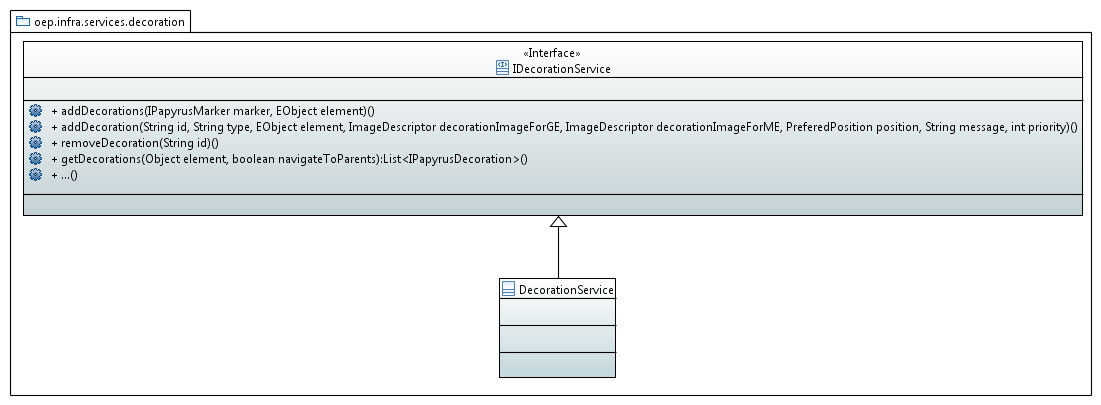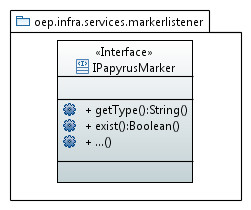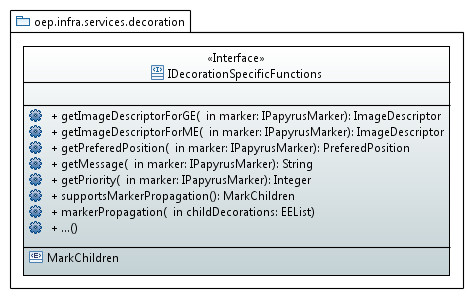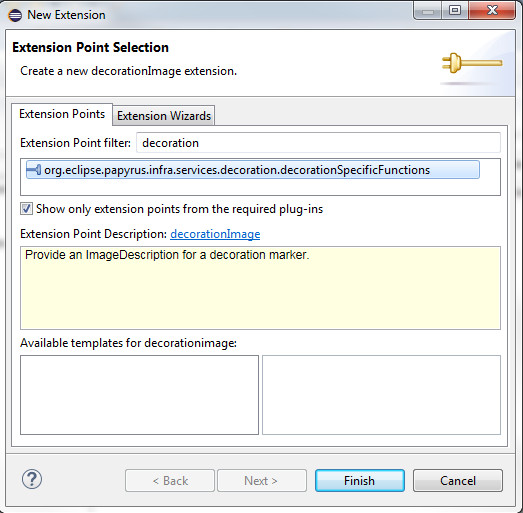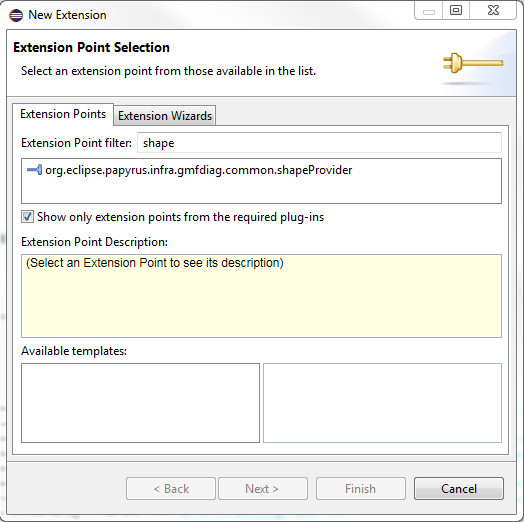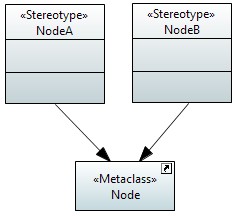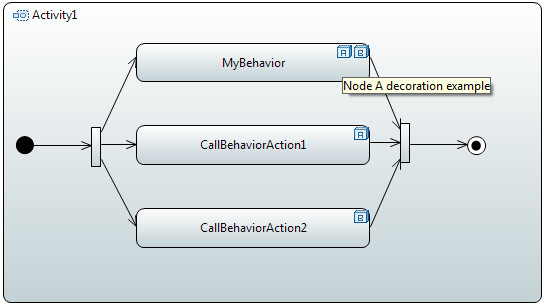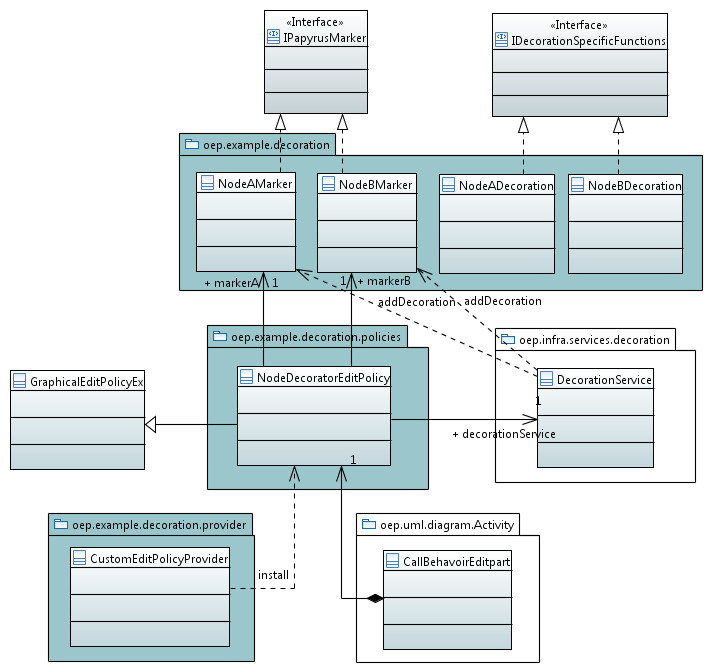Notice: this Wiki will be going read only early in 2024 and edits will no longer be possible. Please see: https://gitlab.eclipse.org/eclipsefdn/helpdesk/-/wikis/Wiki-shutdown-plan for the plan.
Manage Decorators On Papyrus
Contents
- 1 Introduction
- 2 Decoration Service Framework
- 2.1 Architecture
- 2.1.1 DecorationService
- 2.1.1.1 Main methods
- 2.1.1.1.1 addDecorations(IPapyrusMarker marker, EObject element)
- 2.1.1.1.2 addDecoration(String id, String type, EObject element, ImageDescriptor decorationImageForGE, ImageDescriptor decorationImageForME, PreferedPosition position, String message, int priority)
- 2.1.1.1.3 removeDecoration(String id)
- 2.1.1.1.4 getDecorations(EObject element):List<IPapyrusDecoration>
- 2.1.1.1 Main methods
- 2.1.2 IPapyrusMarker
- 2.1.3 IDecorationSpecificFunctions
- 2.1.3.1 Main methods
- 2.1.3.1.1 getImageDescriptorForGE(IPapyrusMarker marker):ImageDescriptor
- 2.1.3.1.2 getImageDescriptorForME(IPapyrusMarker marker):ImageDescriptor
- 2.1.3.1.3 getPreferedPosition(IPapyrusMarker marker):PreferedPosition
- 2.1.3.1.4 getMessage(IPapyrusMarker marker):String
- 2.1.3.1.5 getPriority(IPapyrusMarker marker):int
- 2.1.3.1.6 supportsMarkerPropagation():MarkChildren
- 2.1.3.1.7 markerPropagation(EList<IPapyrusDecoration> childDecorations):IPapyrusDecoration
- 2.1.3.1 Main methods
- 2.1.4 Decoration Image Extension Point
- 2.1.1 DecorationService
- 2.1 Architecture
- 3 Shape Service Framework
- 4 Application Example
Introduction
To manage decorator on Edit Part two solutions are are provided by Papyrus:
- Decoration Service Framework
- Shape Service Framework
The purpose of this documentation is to give the minimum information to deploy your own decorator for Papyrus elements as EditPart.
...TODO differences...
shape=svg
shape= if already using an svg file as shape of the edit part, using of shape provider can be problematic.
decoration=icons
shape: shapeCompartment+position
decoration:top-right
decoration:top-right
... ...
Decoration Service Framework
Architecture
The decoration service architecture have already been describe on a document (here). You will find here a description of mains Interfaces or classes to be implemented or to be called in order to use the framework and adds specific decoration.
DecorationService
Decoration service permits to manage decoration on EObject. Decoration are adds throw this service. It provide listener to observe changes. This service can be get with:
DecorationService decorationService = ServiceUtilsForEditPart.getInstance().getService(DecorationService.class, editPart);
Main methods
addDecorations(IPapyrusMarker marker, EObject element)
Add a new Decoration to a decorations Map with an IPapyrusMarker associated to an element.
addDecoration(String id, String type, EObject element, ImageDescriptor decorationImageForGE, ImageDescriptor decorationImageForME, PreferedPosition position, String message, int priority)
Add a new decoration without passing by a marker.
removeDecoration(String id)
Remove a decoration from the decorations Map,
getDecorations(EObject element):List<IPapyrusDecoration>
Return an Interface of decoration (IDecoration) for the element
IPapyrusMarker
IPapyrusMarker provide a protocol for markers that annotate elements with information, often used for problems. It is an analogue of the Eclipse IMarker API for resources in the workspace. To be implemented to create its own marker used for custom decoration.
Main methods
getType():String
Return the type of the concret Papyrus marker. Is also used to link a decorator to the marker(see Decoration Image Extension Point).
exist():Boolean
Return true if the marker exists on the view.
IDecorationSpecificFunctions
This interface allows to access a set of functions that depend on the decorator type. The objective is that plug-ins for a specific decoration type can implement this interface (via an extension point) to provide the information that depends on the decoration type, notably the used icons, their position, the way how messages are calculated and how decoration might propagate from children to parents. To be implemented to create its own decoration. Is related to a marker throw decorationImage extension point.
Main methods
getImageDescriptorForGE(IPapyrusMarker marker):ImageDescriptor
Get the image descriptor for a graphical editor.
getImageDescriptorForME(IPapyrusMarker marker):ImageDescriptor
Get the image descriptor for model explorer. May be identical to the image for a graphical editor.
getPreferedPosition(IPapyrusMarker marker):PreferedPosition
Return the preferred position for markers within the model explorer.
getMessage(IPapyrusMarker marker):String
Return a textual information for the marker (used for fixed messages that do not need to be stored in each marker).
getPriority(IPapyrusMarker marker):int
Return the priority of a decoration. This enables to select a marker with a high priority, if multiple markers for the same model element and the same position exist.
supportsMarkerPropagation():MarkChildren
Does the decoration type support a propagation from child to parent, e.g. in case of a problem marker parents (package) might be marked as containing warnings or errors.
markerPropagation(EList<IPapyrusDecoration> childDecorations):IPapyrusDecoration
Calculate a propagated marker for the parent, given the set of child decorations. Return the calculated decoration for the parent depending on a set of decorations on children.
Decoration Image Extension Point
Provide an ImageDescription for a decoration marker. It permits to link a IDecorationSpecificFunction class to a Papyrus marker throw is type.
Identifier:
org.eclipse.papyrus.infra.services.decoration.decorationImage
Shape Service Framework
The shape service framework permits to be display svg document on the symbol compartment or in a chosen position on the edit part.
Architecture
AbstractShapeProvider
The framework provide a simple abstract provider class in order to add svg shape to edit parts. Only few methods have to be implemented.
Main methods
getShapes(EObject view):List<RenderedImage>
Returns the list of shapes proposed by this provider or null if no shapes have to be displayed by this provider.
getSVGDocument(EObject view):List<SVGDocument>
Return the list of SVG DOCUMENT or null if no shapes have to be displayed by this provider.
providesShapes(EObject view):Boolean
Returns true if the provider can display shapes. This methods allows to compute if shapes can be displayed instead of computing the whole list of shapes to be displayed.
ShapeProvider Extension Point
To be load, implemented shape providers have to be linked throw a specific extension point.
Appearence tab
To display the shape on the edit parts and to choose the position visibility and the position, attributes have to be set on the appearance tab of the properties view.
Application Example
This part will provide a simple example using decorator service. This example will permit to display decoration on edit part according to the conditions describe just before.
Context
The allocation profile used will be the SysML Profile. An allocation table is used, where it allocates the call behavior on nodes. Nodes can be stereotyped with NodeA and NodeB stereotypes. Depending on the node on which the callbehavior is allocated, the decorator in callbehavior the activity diagram should change.
Example
With this profile:
Applied on these two nodes:
And with this allocation Table:
The expected result is:
Implementation architecture
On this example, we have used 2 markers and one decoration specific function for each marker. The association between markers and decoration are done thanks to a specific extension point. An Edit policy is used to add markers to the decoration Service according to the model context. The edit policy is install to the right edit parts throw an edit policy provider, which is load by extension point.
The markers
For each type of stereotype NodeA and nodeB, a marker have been implemented with a specific markerType:
public class NodeAMarker implements IPapyrusMarker { public static final String MARKER_TYPE = "org.eclipse.papyrus.infra.services.decoration.example.NodeA"; //$NON-NLS-1$ public static final String NODE_A_STEREOTYPE = "DecorationExampleProfile::NodeA";//$NON-NLS-1$ protected View notationElement; public NodeAMarker(final View notationElement) { this.notationElement = notationElement; } @Override public boolean exists() { return ExampleUtils.isAllocatedTo((CallBehaviorAction) notationElement, NODE_A_STEREOTYPE); } @Override public String getType() throws CoreException { return MARKER_TYPE; } @Override public String getTypeLabel() throws CoreException { return "Node A marker example"; } ...
The NodeDecoration EditPolicy
These markers are add to the DecorationService thanks to a editPolicy applied to the CallBehavoir edit part.
The DecorationService is call in the Activate() method:
@Override public void activate() { super.activate(); // TODO install listener try { decorationService = ServiceUtilsForEditPart.getInstance().getService(DecorationService.class, getHost()); refresh(); } catch (final ServiceException ex) { // Ignored; do nothing } }
The refresh method adds or removes markers according to the allocated element on the UML element of the edit part:
@Override public void refresh() { ... // If the marker already set for nodeA have to be changed. if (ExampleUtils.isAllocatedTo((CallBehaviorAction) view.getElement(), NodeAMarker.NODE_A_STEREOTYPE) != isNodeAMarked) { isNodeAMarked = !isNodeAMarked; if (isNodeAMarked) { decorationService.addDecoration(getMarkerA(), getView()); } else { decorationService.removeDecoration(getMarkerA().toString()); } getHost().refresh(); } // If the marker for nodeB already set have to be changed if (ExampleUtils.isAllocatedTo((CallBehaviorAction) view.getElement(), NodeBMarker.NODE_B_STEREOTYPE) != isNodeBMarked) { isNodeBMarked = !isNodeBMarked; if (isNodeBMarked) { decorationService.addDecoration(getMarkerB(), getView()); } else { decorationService.removeDecoration(getMarkerB().toString()); } getHost().refresh(); } }
The CustomEditPolicy Provider
An edit policy provider is use to install the NodeDecorationEditPolicy to the right edit parts.
public class CustomEditPolicyProvider implements IEditPolicyProvider { protected String diagramType = org.eclipse.papyrus.uml.diagram.activity.edit.parts.ActivityDiagramEditPart.MODEL_ID; @Override public void addProviderChangeListener(final IProviderChangeListener listener) { } @Override public boolean provides(final IOperation operation) { boolean provide = false; String currentDiagramType; // get the element final EObject referenceElement = ((View) ((CreateEditPoliciesOperation) operation).getEditPart().getModel()).getElement(); // Test if it's a creation operation and the element is a CallBehavoirActino if ((operation instanceof CreateEditPoliciesOperation) && (referenceElement instanceof CallBehaviorAction)) { // Get The current diagram type currentDiagramType = ((View) ((CreateEditPoliciesOperation) operation).getEditPart().getModel()).getDiagram().getType(); // Test if we are on an Activity Diagram if ((diagramType != null) && (diagramType.equals(currentDiagramType))) { provide = true; } else { provide = false; } } return provide; } @Override public void removeProviderChangeListener(final IProviderChangeListener listener) { } @Override public void createEditPolicies(final EditPart editPart) { editPart.installEditPolicy(NodeDecoratorEditPolicy.EDIT_POLICY_ROLE, new NodeDecoratorEditPolicy()); } }
This edit policy provider is installed with the editpolicyProviders extension point:
The Decoration Specific Function
The decoration specific function specify the decoration to be applied on a marked element. It's define the image, the position, the context message of the decoration etc...
public class NodeADecoration implements IDecorationSpecificFunctions { @Override public MarkChildren supportsMarkerPropagation() { // This marker should not be propagated return null; } @Override public ImageDescriptor getImageDescriptorForGE(final IPapyrusMarker marker) { return org.eclipse.papyrus.infra.widgets.Activator.getDefault().getImageDescriptor(Activator.ID, "icons/NodeA.gif"); //$NON-NLS-1$ } @Override public PreferedPosition getPreferedPosition(final IPapyrusMarker marker) { return PreferedPosition.NORTH_EAST; } @Override public String getMessage(final IPapyrusMarker marker) { return "Node A decoration example"; } @Override public int getPriority(final IPapyrusMarker marker) { return 0; } }
To associate decoration specific function to a marker, an extension point are used. In the image below the decoration NodeAdecoration is linked to the marker type define on the marker NodeAMarker.MARKER_TYPE
Sources
The plugin of this example can be retrieve in the Papyrus git code repository here.

